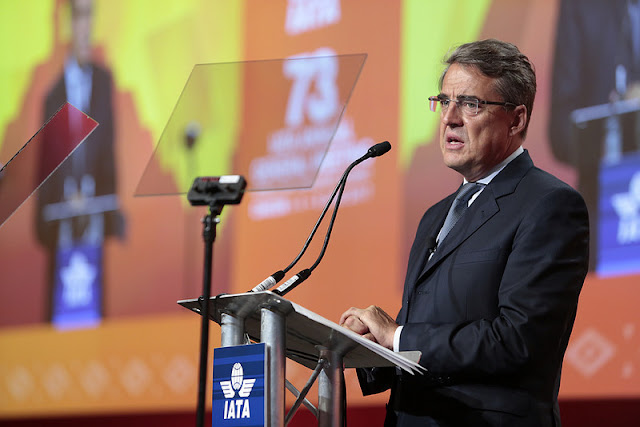Closer Collaboration Key to Enhancing Aviation Security
 |
| Alexandre de Juniac, IATA’s Director General and CEO |
The International Air Transport Association (IATA) 73rd
Annual General Meeting (AGM) adopted a resolution reaffirming the airline
industry’s commitment to safety and security. It also called for greater
collaboration among all government and industry stakeholders to keep flying
secure with risk mitigation measures that maximize the protection of passengers
and crew while minimizing disruption to passengers and the economy at large.
"Aviation is a target for terrorists intent on
destroying the freedom that is at the heart of our business. Information
sharing among governments and with the industry is the key to staying a step
ahead of emerging threats. We have the same goals—to keep passengers and crew
safe. So it only makes sense that we work together as closely as
possible," said Alexandre de Juniac, IATA’s Director General and CEO.
The Resolution highlighted the importance of UN Security
Council Resolution 2309, which called for governments to meet their
responsibility to keep citizens secure while traveling by air. It also
reaffirmed the industry’s strong support for the development by the
International Civil Aviation Organization (ICAO) of the Global Aviation
Security Plan (GASeP). As a goal, GASeP should significantly enhance the
clarity, simplicity, and focus of ICAO’s global standards for security (Annex
17 of the Chicago Convention) so that there is no ambiguity in the
responsibilities of states.
"GASeP must be a pragmatic and nimble framework for all
parties involved in aviation security to work together. No single entity has
all the answers. By combining our strengths more efficiently, the security of
passengers and crew will be better served," said de Juniac.
The Resolution urges governments to:
Engage the industry in early dialogue when faced with a
security threat to ensure that workable and effective response measures are
developed that can be implemented efficiently to maximize passenger safety and
minimize disruption
Work in partnership with each other and with airlines,
airports and other aviation security stakeholders to develop effective,
long-term, security measures that effectively counter threats to aviation
Take greater accountability for the implementation of ICAO
standards and security measures and urgently address any gaps identified
through ICAO’s Universal Security Audit Program (USAP)
Fast-track the GASeP roadmap into National Civil Aviation
Security Programs as soon as possible.
"The timing of the resolution is significant. Public and
industry confidence has been rattled by inconsistencies in how some states have
responded to concerns over the potential for explosives to be concealed in
large portable electronic devices (PEDs). It highlights the reason why we need
better information sharing and better coordination to achieve risk mitigation
measures that maximize the protection of passengers and crew while minimizing
unnecessary disruption," said de Juniac.
The resolution also recognizes the important role of industry
in helping governments to keep flying secure.
The resolution commits airlines
to:
Implement prescribed security standards and recommended
practices to the highest level
Support Governments in the development and implementation of
additional security measures when required to protect air transport
Support the development and implementation of industry-driven
aviation security initiatives such as Smart Security, Passenger Name Record
(PNR) /Advance Passenger Information (API)
Enhance industry standards by promoting the implementation of
self-assessment and independent verification audit programs such as the IATA
Operational Safety Audit (IOSA) and IATA Safety Audit for Ground Operations
(ISAGO)
"Under the guidance of governments, the industry works
hard to improve processes and develop new technology to counter the evolving
threat to aviation security. Lengthy processes to get new technology into
operation is, however, a bottleneck that needs to be fixed. For example, it’s
clear that the long-term solution to mitigating PED threats is better screening
technology. But without far greater government investment and support to
accelerate development and certification of this new technology, its potential
will not be realized," concluded de Juniac.



Comments
Post a Comment